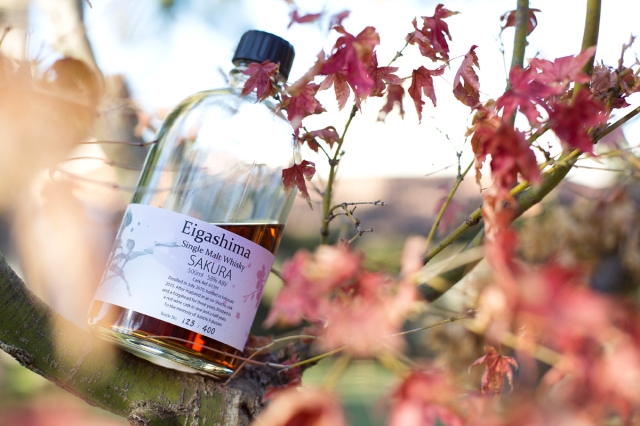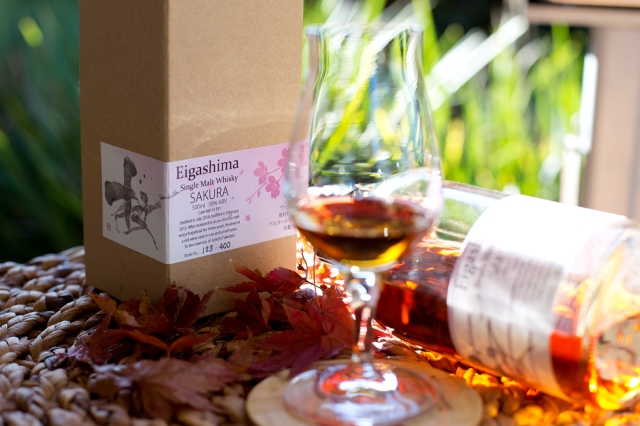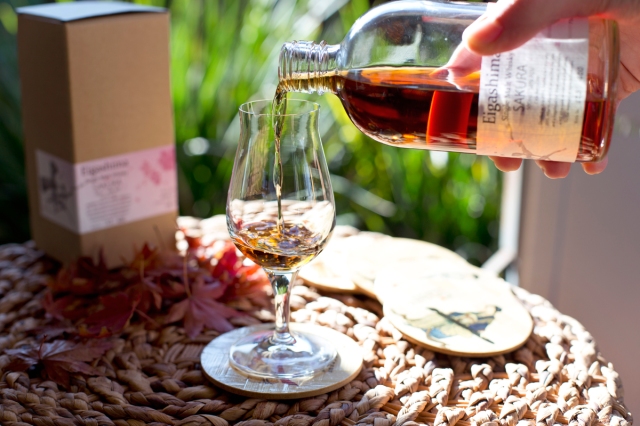A quick glance at the label on this bottle confirms that this is a bit of an interesting one.
Distilled in July 2010, the Eigashima Sakura was matured in an ex-Shochu cask and a hogshead for a combined period of three years, before being finished is a red wine cask for a further one and half years before being bottled at 58% ABV.
I don’t know about you, but there are a few words on this label that I wasn’t immediately familiar with, namely the words Eigashima and Shochu. I have heard of both, but I must admit I had to hit the books (aka Google) and do a bit of research to really understand and appreciate this one.
Eigashima
We’ll start with Eigashima. You may not have heard of Eigashima, but you may have heard of another small Japanese distillery called Akashi. Well, in basic terms, they’re kind of one and the same.
Located just our of Kobe, Japan, Eigashima is the parent company that runs the White Oak Distillery, who produce whisky bottled under the Akashi brand. Interestingly, they only produce whisky for two to three months a year and with a team of just four people, they’re the smallest whisky distillery in Japan.
So if they’re only making whisky for a couple of months a year, what are they doing the rest of the time? Well that leads us to that second word I wasn’t overly familiar with..
Shochu
You see, Eigashima’s core business is producing two of Japan’s favourite distilled drinks, sake and shochu. Sake is essentially a brewed rice wine, but shochu is quite a bit different. It’s first brewed, then distilled and can be made from a variety of different ingredients including sweet potatoes, barley, buckwheat, rice, sweet corn or even brown sugar. After distillation it’s then matured for a relatively short time (compared to whisky), in either stainless steel tanks, clay pots or – you guessed it – wooden casks!
There’s a lot more to it and the history and production is quite fascinating, so feel free to check this out for further info.
Eigashima Sakura
Now that we know a bit more about Eigashima and Shochu, I’d say it’s time we taste. Kanpai!
When first poured, I’d say that the Sakura isn’t immediately recognizable as whisky. I get more of a plum wine and Slivovitz top note on a bed of raw white grain spirit and as it sounds – it’s not great. Air is its friend though. Fifteen minutes in the glass opens this dram right up to reveal a rich, thick nose of runny toffee, marmalade, balsamic reduction and heavily charred figs. I get a hint of potpourri, char and dark soy. It’s not sherried, it’s almost like an older complex Armagnac, but that grainy vodka-like spirit notes pokes it head through here and there.
On the palate it’s immediately oily giving rise to a burst of spirit heat which quickly fades to deliver sweet, chewy berry notes, brown sugar and a slight fizz. The residue is almost savory though, with a saline tang turning very dry and tannic on the finish with a slight bitter waxiness.
I would never pick this as a sub-five year old whisky and despite the young age and high proof, I have no desire to add water to this one. There’s so much going on which makes me think Eigashima have been very clever with their cask selection here. However, as is often case with heavy wine finishes, the drying bitter finish isn’t quite the crescendo I was looking for.
Having never tasted Shochu, I can’t really comment on the influence the shochu cask has had on this whisky. However, even before reading up on it, I did get a distinct white grain/potato spirit (almost vodka-like) note on the nose. I don’t know what type of shochu cask was used in the finishing (sweet potato, barely, brown sugar etc.), but this was a really interesting note, in a really interesting whisky.




